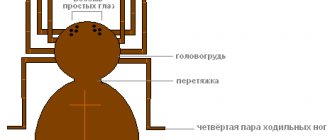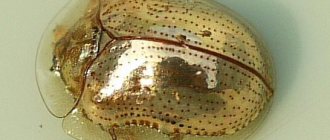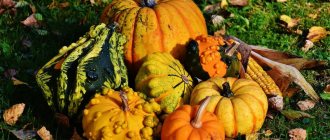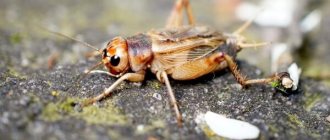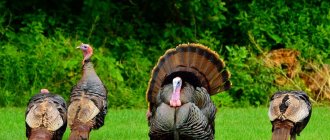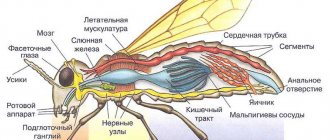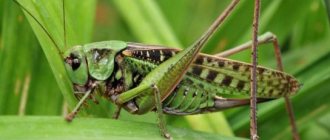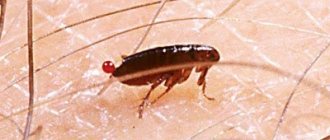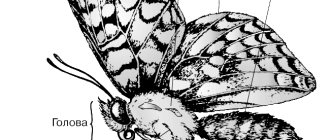During evolution, some insects changed the structure of the front pair of wings. The result was hard elytra filled with chitin. Because of this, the new order received the name “Coleoptera”, and popularly simply “beetles”. In terms of quantity and diversity, this is the largest group of living beings on the planet. Let's look at all the variety of species and in our review the most beautiful species of beetles living in nature.
Photos of the most beautiful species of beetles:
1
Ground beetles
These creatures belong to the suborder of carnivorous Coleoptera and for the most part form a large family, in which scientists number about 25 thousand species alone, although there is an assumption that twice as many of them live on Earth. Moreover, about three thousand varieties are found in Russia.
These are very large beetles, the size of which reaches 6 cm, but for the most part is about 3 cm. They are mostly dark in color, often with a metallic, sometimes rainbow tint. However, the colors of the species are varied, as is the shape of their bodies. Most of the varieties have underdeveloped wings, and therefore almost do not fly, but they develop considerable speeds when running.
Most often they are predators, and therefore feed on worms, butterflies, snails, slugs and only a little plant food. Ground beetles go hunting at night and become especially active on cloudy days in the warm months. Their main habitat is the upper layers of soil; in rare cases they can be seen on trees and other plants.
Golden ground beetles, which live in Europe and central Asia, are considered the most voracious. They love to feast on gypsy moths, and by eating this pest of cultivated plants, they bring undoubted benefits. The purple ground beetle is also famous for its good appetite, which is very useful.
The main color of such beetles is dark, but with a purple border, which is why the species received its name. But the grain ground beetle loves to thoroughly gnaw the germinating grains of grain crops. This causes terrible damage to the crop, and for this reason it is considered a pest.
Twirly
This family of small-sized water beetles (on average about 6 mm) includes several hundred species, mostly inhabiting tropical waters, but such beetles are also found in the northern regions, in particular in fresh water bodies near the Black Sea coast, in Sweden, Norway, Spain. And a couple of dozen species live in Russia.
Such beetles, like the previous ones, belong to the suborder of carnivores and feed on small aquatic life, not only alive, but also dead. Their way of digesting food is very interesting, because the main processes occur not inside, but outside their body. The spinners inject enzymes into their prey, which dissolves it, and then only suck it up.
The body shape of such creatures is oval, convex; The color is predominantly black and shiny. On the surface of the water they move energetically, quickly, stay in groups, constantly describing circles and dancing in circles without rest, for which the beetles got their name. And only sensing a threat, they dive into the water.
In addition, they can fly, as they are naturally endowed with membranous, well-developed wings. For their tirelessness, these waterfowl insects have been awarded the title of the fastest swimmers among their own kind. The largest species of such organisms are found in East Asia; their representatives can grow to a size of two or more centimeters.
Leaf beetles
The species has 32,000 varieties. Insects have an elongated or spherical body of a rich blue or golden color. The size of the female’s body does not exceed 16 mm.
The most common representative of the subspecies is the mint leaf beetle . It has a small, smooth, convex body of blue-green color. The maximum size of an insect is 11 mm. The green leaf beetle loves to feast on mint leaves, which is why it got its characteristic name.
ladybugs
What types of beetles are most recognizable in Russia ? Ladybugs have been familiar to us since childhood and are common not only here, but throughout the world. In total, about 4 thousand species of these creatures are known, which are united in the family of ladybugs. Their habitat is a variety of plant types. Some species spend their lives on trees and shrubs, others on field and meadow grasses.
Being members of a suborder of carnivorous beetles, these useful creatures, measuring approximately 5 mm in size, are known as aphid killers. They protect themselves from their enemies by spraying a yellow, unpleasant-smelling, poisonous liquid, a kind of milk. It is believed that it was for this feature that these insects were called ladybugs.
Their colors are always bright. The elytra usually have rich red or yellow colors, but sometimes brown, blue, black, and are also decorated with dots, the number and shade of which can vary. Representatives of this family also belong to the species of flying beetles .
Brazilian bigtooth woodcutter / Macrodontia cervicornis
One of the largest beetles in the world. Because of its large horns, it received a Latin name, which is translated into Russian as “large-toothed staghorn.”
Biologists recorded a maximum size of 178 mm. The stag-horned representative of the Coleoptera settled in the southern part of the South American continent. They feed on leaves and flower pollen. They easily split the bark of trees with their horns.
A very rare species. It is under guard. He has many natural enemies. Birds happily eat larvae, as well as adults.
13
Swimming beetle
This is an underwater predatory coleopteran that inhabits standing deep waters with abundant vegetation. In this environment, such carnivorous creatures always have a huge supply of food, that is, a variety of living creatures. Sometimes these creatures even choose small fish and newts as their victims.
By the way, having caught them, they are able to absorb them with amazing gluttony and speed. The larvae of such beetles are also very dangerous. They launch predatory mandibles into their victims, through the channels of which digestive juice passes, and back they suck in food that is already suitable for consumption in a digested state.
Numerous species of such beetles are grouped into the diving beetles family. One of its representatives has a flat, oval, dark green body on top, bordered by yellowness at the edges, which is why the species is called “bordered swimmer.” Its hind pair of legs is covered with hairs and has a paddle-like shape.
And the body itself is similar in structure to a submarine: it is rounded, smooth and flat. Thus, nature itself made sure that these creatures, no more than 5 cm long, felt at ease in the water element, moving there energetically and agilely. But such insects are also capable of moving on land. They usually reach areas near bodies of water by air, using their wings.
How to get rid of flour beetles
The first thing to do if these beetles appear in your apartment is to throw away bulk products. If it’s a pity to throw away the cereal and flour, calcining it in the oven or freezing it at 10 degrees below zero will help kill the larvae and beetles.
It is worth remembering that the eggs are sown in other places, so the second thing is to do some general cleaning:
- wash with water and vinegar, then provide ventilation by opening the windows;
- spray or wipe the baseboards and adjacent floor with a chemical;
- Rinse open containers in vinegar solution, use hot steam or boiling;
- Place the products in a tightly sealed glass container.
Colorado beetle
It just so happens that carnivorous types of beetles are for the most part considered beneficial because they eat small pests from among their insect relatives. And the more insatiable the predator, the more benefit it brings. Of course, we judge from the point of view of us, people.
But humanity has disliked vegetarian beetles, for example, members of the leaf beetle family, especially a representative of one of its species - the Colorado potato beetle . The fact is that adult individuals of these insects, along with the larvae, eat the leaves of eggplants, tomatoes, peppers with insatiable gluttony, but are especially fond of potato beds.
These terrible pests, no more than a centimeter in size, have turned into cruel invaders of our territories quite recently. Apparently, they were brought to Russia by chance. These foreigners come from the New World, more precisely from Mexico, where they initially ate tobacco and wild nightshade leaves.
Later, having adapted to feast on the potato plantings of the colonists, they gradually began to spread north to the United States, in particular they really liked it in Colorado. That's why beetles are called that way. The head and chest of such insects are orange with dark markings. The body is shiny, elongated, oval.
The elytra are decorated with black longitudinal stripes. Having recognized this terrible beetle by its signs, gardeners should immediately take action and vigorously fight the terrible aggressor. After all, Colorado potato beetles reproduce quickly.
And they are so voracious that they almost completely eat potato bushes, and not just the leaves. And having destroyed everything, they spread their wings and travel safely in search of new places rich in food, conquering more and more new areas.
Marbled beetle / Polyphylla fullo
A large representative of coleopteran insects of the Khrushchia subfamily. Adults grow up to 4 cm.
It is easy to recognize by its characteristic marble pattern. There are white spots of different shapes on the dark body. Because of this original coloring they received their specific name. At the front of the head are two large antennae.
A large beetle has spread throughout southern Europe. It feeds on leaves, flowers of fruit and agricultural plants. The larva happily eats plant roots.
False potato beetle
The immigrants from Colorado described above are an independent species in their family that has no varieties. But in nature there are beetles very similar to them, practically twin brothers, with the only difference that they do not cause much harm to potatoes and other garden plants.
They also feed on nightshades, but not cultivated ones, but weeds. But they are called potato beetles, only falsely. It’s just that they are really very similar to the terrible American pests we know, as well as their larvae. Only the colors of their clothes are not so bright, but noticeably more faded. The elytra are almost white, but are marked with the same longitudinal stripes.
Wood boring beetles
Another type of vegetarian beetle has turned into a terrible enemy of humanity. And it is not surprising, because they are not only destroyers of garden trees, but also terrible destroyers of wooden buildings and furniture, because they feed on wood.
Let's list the most famous types of wood-boring beetles , and also tell you in more detail about their unseemly activities. Here they are:
1. The house longhorned beetle, a representative of the longhorned beetle family, which also received the nickname of the house woodcutter, is a so-called technical pest because it rarely harms living trees, but only those that have been cut down and cut down. It is found only in dry, dead wood, mostly coniferous trees. Adult beetles are usually about 7 mm or more in size. They have an oblong body, rounded at the back, most often dark brown in color, covered below with erect, light hairs.
In the course of their life, such wood lovers lay winding labyrinths in it, where they leave their elongated, whitish eggs. Those wooden objects where such beetles settle, after some time become covered with a coating similar to flour, then become unusable and are destroyed;
2. Hooded beetles are also a whole family of tree pests. Its representatives are bugs, about one and a half centimeters in size. In Europe, the most common variety has a black front and red back.
In Arabia and Africa, another one became especially famous: brown in color with protruding pectoral processes, similar to horns. The entire family includes about 7 hundred species. Most of them live in the tropics;
3. Representatives of the family of drillers are famous for the width of the moves they make, for which they received their nickname. The most attractive wood species for them are walnut and oak. Interestingly, such beetles feed not on the wood itself, but on fungal mold, for the growth of which favorable conditions are created due to the penetration of moisture into the damage. Most often, beetles are reddish in color. They have very elongated, thin bodies, averaging about 1 cm in length;
4. Grinders are another family of wood pests. For the most part, these are reddish-brown bugs, no more than a centimeter in size, with a comb-shaped antennae. They feed on both dead and living wood, and are sometimes found in food and medicine. In the process of life, they emit very strange sounds, similar to the ticking of a clock, by which one can recognize the settlement of unpleasant guests;
5. Bark beetles are a subfamily of the weevil family. There species of bark beetles around the world, and more than a hundred in Europe. These are small dark brown creatures, the largest of them reach 8 mm in size, but there are also very small ones, only a millimeter in size.
They are capable of infecting living trees, even the stems of some grasses, penetrating deeply into their tissues. If they start in dead wood, then not in dry wood, but in wet wood. Some varieties spread fungal mold spores, which subsequently serve as food for their larvae.
Such organisms live in the tropics, as well as in areas with temperate climates, including Europe. Often hordes of beetles become a real natural disaster, destroying literally everything wooden in their path.
Folk remedies for Khrushchak
As a pest repellent, use laurel leaves, lavender or Caucasian chamomile in the form of dried herbs, soaked swabs in a decoction, or choosing an aromatic essential oil.
If there are a lot of supplies, then steel hoops are put on the bags, metal lids and nails are placed on the dishes - the Khrushchaks do not like this metal. Beetles also cannot stand the smell of garlic and citrus, so garlic and lemon or orange peels are placed in jars of food.
Every month it is useful to treat cabinets and other food storage areas with a disinfectant solution: add 1 tbsp of soda and vinegar to 1 liter of warm water. l.
I use boric acid (borax) as bait - when eaten by a beetle, it poisons its body inside. Mix borax with powdered sugar or flour, semolina, honey or other products that attract the pest. Sprinkle on leaves and place on shelves in kitchen cabinets.
May beetles
These coleopterous insects are among the fairly large ones, reaching a length of at least 2 cm, in some cases more than 3 cm. They get their name from the fact that they appear and begin to fly actively at that period of the year when spring nature blooms in lush colors, warmed the gentle light of the May sun.
The beetles have an oval-shaped, red-brown or black-colored body strewn with hairs, in some cases slightly green, sometimes with yellowish elytra.
Such insects, if their numbers are large, can cause considerable harm to cultivated and wild plants by eating their young shoots. Their larvae are very voracious and feed on the roots of trees and shrubs. species of May beetles. And all of them are united in a genus with the same name.
Fireman Beetle
This representative of the soft-bodied family also bears the name “country soft-bodied”. This is because the covers of its body, unlike its relatives in the order, are not hard chitinous, but soft, as well as flexible weak elytra. If it were not for the toxic substances secreted by these creatures, then they would have had a bad time in such clothing, which is so little capable of protecting them from their ever-watchful enemies.
Such beetles have an elongated body, up to 2 cm in size, equipped with segmented thread-like antennae at the front. They have a fire color, that is, a color where dark tones are contrastingly combined with bright shades of scarlet.
These are predators that hunt small prey, killing it with powerful poisonous bites and consuming it. And since these creatures are dangerous carnivores, they become useful to humans. And gardeners are trying to attract such insects to their plots. Firefighters destroy leaf beetles, caterpillars, aphids and other pests.
Killer Cow
We have already mentioned enough species of black beetles . Ground beetles, whirligigs, some longhorned beetles and cockchafers may have this color. And even the firefighter beetle just described has extensive dark areas in its outfit.
But few of us have seen black ladybugs. However, they exist. This is a type of Asian ladybird. It may be black, decorated with red dots; it can also be yellow-orange with numerous blurry spots of black.
Such creatures are usually larger than other cow relatives, measuring about 7 mm. They are given the nickname killer cows because among insects they are fearsome and insatiable predators. We have already noticed that carnivorous beetle species tend to be beneficial.
And here we can assume that the more active the predator, the more positive its activity is for humans. The Americans thought the same thing about a quarter of a century ago. But they made a mistake by bringing the Asian ladybird to their lands, in the hope that it would become a successful destroyer of annoying midges and aphids.
The fact is that such cows, called “harlequins,” in addition to harmful insects, devour their fellow cows, other types of cows, which are very useful and valuable. Moreover, they damage grapes and berries. Now, having realized their mistake, they are fighting them, however, it is useless, because the dangerous species is spreading more and more widely.
European countries have already suffered from it, in particular Belgium, France, and Holland. In winter, Asian women climb into human homes, causing allergies in their owners. But no reliable means of combating killer cows have yet been invented.
Sacred Scarab / Scarabaeus sacer
In Ancient Egypt, if a scarab was encountered on the way of an army, it turned back. The most revered symbol in the mythology of Ancient Egypt.
Today, the habitat is limited to southern Europe, North Africa, and the steppe regions of Eastern Europe. It is found in Kazakhstan, Turkey, and on the islands of the Mediterranean Sea. The body color is black, and with age, adult specimens become shiny.
One of the features is the ability to roll manure balls. In many European countries, the scarab is listed in the Red Book.
9
Hercules beetle
This resident of the New World, in particular the tropical forests of the Caribbean islands, as well as the southern and central part of the American continent, is famous for its remarkable parameters. It was thanks to them that he became the record holder for size among the beetles of the planet. Its maximum size can be up to 17 cm. Just think, only its gigantic wings can boast a span of 22 cm.
In addition, the appearance of the Hercules beetle is very unusual. The front part of the body is black and shiny. The head of males is decorated with a huge, forward-pointing upper horn, equipped with teeth.
There is also a second, smaller one, located lower and extending from the pronotum. The body of the beetle is slightly hairy, but such vegetation is quite sparse and red in color. The elytra come in different shades: olive, yellow, brown, and sometimes gray-blue.
The beetle got its name not only for its outstanding size, it has tremendous strength. But giants are quite harmless to others and humans. For the most part, they feed on dry tree bark, fallen leaves, slightly rotten fruits and other organic matter that has undergone changes, thereby benefiting the ecosystem.
Beetles need horns for fights with their own kind, because in relation to other Hercules they are very militant. They fight for spheres of influence, for a place in the social hierarchy, but most of all because of females. And in a fight for the latter, they are capable of severely injuring and even killing their opponents.
Goliath beetle
Continuing to describe the types of large beetles , it is necessary to mention this African insect. The dimensions of these creatures are somewhat smaller than those of the previous heroes, their length on average is about 10 cm. However, among beetles on a global scale they are on the list of champions in terms of weight, reaching up to 100 g.
The color of such beetles is mostly black, decorated with a complex white pattern; there are brown-gray specimens with a black pattern. These beetles spend most of their lives in the air. They feed on overripe fruits, pollen and tree sap.
This genus of beetles has five species and is closely related to the May beetles. The only and main enemy of such wonderful insects in nature is man. And the biggest danger is the possibility of ending up in an entomologist’s collection.
Alpine longhorned beetle / Rosalia alpina
There is such an original beetle in the world that has spread throughout Europe. Forest beetles in the mountains rise to a height of 1,500 meters above sea level, which is why they received their species name.
Adults grow up to 3.5 cm in length. The body, head, limbs and antennae are covered with an original pattern. You won’t find specimens with the same color.
The barbel is the only representative of the relict genus Rosalia, which lives in the vast expanses of Europe. The number of the species is declining. The main cause of extinction is deforestation.
6
elephant beetle
Another giant, growing in special cases up to 12 cm. The body of such creatures is predominantly dark, but the brown tint of their color is given by the hairs of this color. In males, a large, upward-curved, black horn grows from the head forward. To some it seems similar to an elephant's tusk, which is why the beetle was given this name.
This is a resident of the American tropics, living in the forests of Venezuela and Mexico. Despite their size, such insects fly beautifully. They feed in approximately the same way as their previous giant brothers. By the way, all three giants belong to the lamellar family.
Nut fruit / Curculio nucum
This beetle is also called the nut weevil, and it lives in the Dubrovnik forests of Europe, where hazel grows in the undergrowth.
It stands out in the order Coleoptera with an unusual proboscis. In females it is slightly longer than in males. There are two antennae on the proboscis. The body of the bug itself is black, but covered with yellowish scales. Because of this, its color appears golden.
Eats hazelnuts, hazel, and can feed on acorns. The female lays eggs in soft hazel fruits. In autumn, the larva gnaws through the shell and falls to the ground. There it burrows into the soil and overwinters.
By the way, on our website most-beauty.ru you can also admire the most beautiful weevils in the world.
4
Stag beetle
The appearance of the beetle , which it is time to introduce, is also very unusual, and its size is large. True, this deer insect is already classified as a different family, called “stag beetles”. This name is not accidental, because the most remarkable feature of the stag beetle’s appearance is a pair of huge antlers, very similar to those of a deer.
The size of these beleopterans reaches 9 cm. This does not qualify for a world record, but insects with such parameters can easily lay claim to championship on a European scale. They are found in Europe, Asia, Africa, and inhabit forests, and therefore the cutting down of trees significantly affects the size of their population.
The beetle larvae grow on dead wood, which serves as food for them. But unlike tree pests, they are only interested in rotten stumps, trunks and branches. Therefore, there is no harm from their vital activity.
general characteristics
Name: Beetles or Coleoptera Lat.: Coleoptera
Class: Insects - Insecta
| Habitats: | everywhere except cold regions |
| Dangerous for: | depending on the type |
| Means of destruction: | folk, chemical, prevention |
Beetles are a group of insects with complete metamorphosis. Almost 3 tons of fossil species have been studied, but a large number are unstudied. They are distributed everywhere, in addition to Antarctica, the Arctic and the highest mountains. But the most attractive specimens can be admired in the tropics.
Fireflies
Representatives of this large family are nocturnal beetles. They have an interesting feature because they glow in the dark. And the reason for everything is oxidative reactions in organs located at the bottom of the abdomen of insects and called lanterns, sometimes they are distributed throughout the body.
Internal light reflectors are also involved in the glow. Moreover, this process is controlled by brain nerve impulses. Fireflies are able not only to “turn on” and “turn off”, but also to regulate the brightness of their “light bulbs” at will.
In this way, they mark territory, scare away enemies, call for sexual partners, and communicate their desires and intentions to their relatives. Light signals can be green, red, blue. And their frequency largely depends on individual and species characteristics, as well as environmental parameters.
Otherwise, fireflies are similar in structure to other beetles. They have an oblong, flat, hairy, brown, brown or black body; upper protective and lower delicate wings that enable flight; comb-like antennae composed of segments; large eyes; gnawing type oral formations, atrophied in adult individuals, since they do not feed on anything, unlike the larvae.
But there are exceptions, because the females of some species resemble dark brown worms in appearance, wingless and with six legs. In conclusion, we note that the presented species of beetles ( in the photo you can see what they look like) are only a small part of those existing in nature.
After all, Coleoptera are so widespread and numerous on the planet that even scientists themselves have no idea about the number of their species in nature. One can only assume that not all of them have been discovered and many of them have not yet been described.


